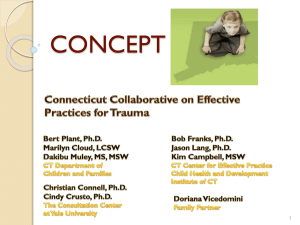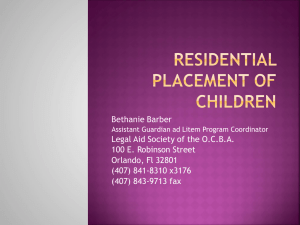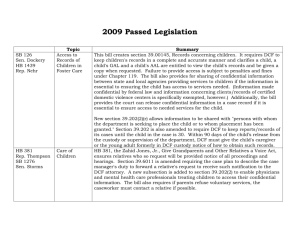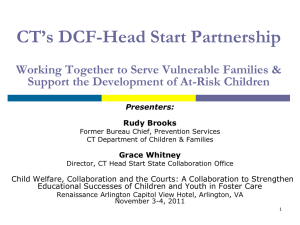DOC - Center for Children`s Advocacy
advertisement
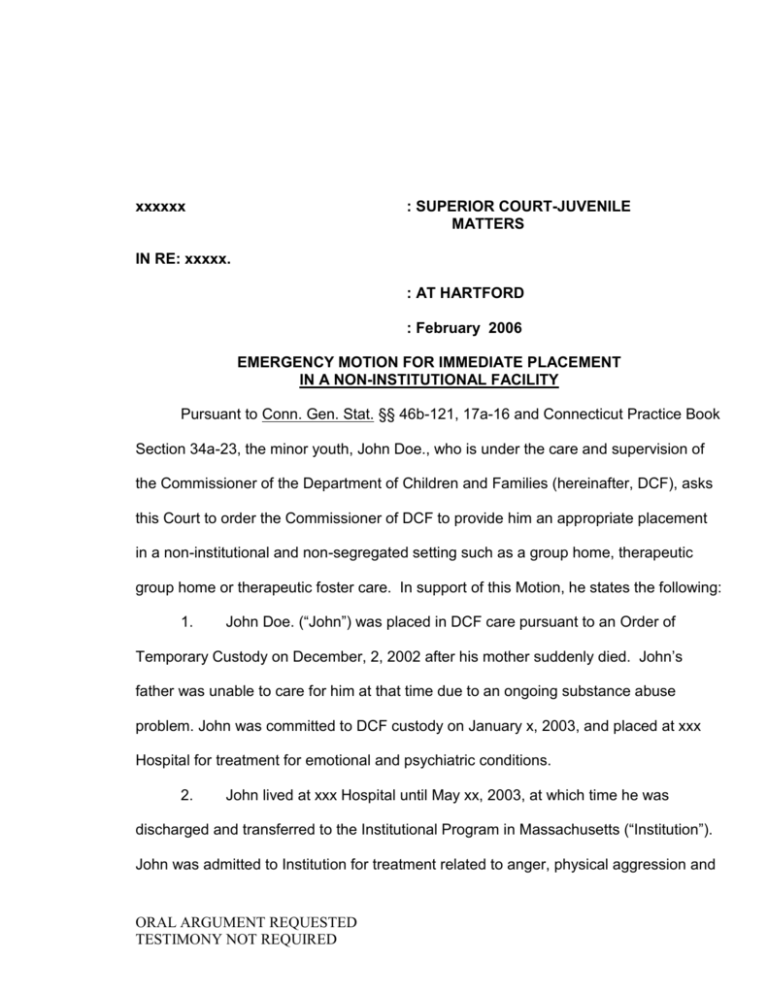
xxxxxx : SUPERIOR COURT-JUVENILE MATTERS IN RE: xxxxx. : AT HARTFORD : February 2006 EMERGENCY MOTION FOR IMMEDIATE PLACEMENT IN A NON-INSTITUTIONAL FACILITY Pursuant to Conn. Gen. Stat. §§ 46b-121, 17a-16 and Connecticut Practice Book Section 34a-23, the minor youth, John Doe., who is under the care and supervision of the Commissioner of the Department of Children and Families (hereinafter, DCF), asks this Court to order the Commissioner of DCF to provide him an appropriate placement in a non-institutional and non-segregated setting such as a group home, therapeutic group home or therapeutic foster care. In support of this Motion, he states the following: 1. John Doe. (“John”) was placed in DCF care pursuant to an Order of Temporary Custody on December, 2, 2002 after his mother suddenly died. John’s father was unable to care for him at that time due to an ongoing substance abuse problem. John was committed to DCF custody on January x, 2003, and placed at xxx Hospital for treatment for emotional and psychiatric conditions. 2. John lived at xxx Hospital until May xx, 2003, at which time he was discharged and transferred to the Institutional Program in Massachusetts (“Institution”). John was admitted to Institution for treatment related to anger, physical aggression and ORAL ARGUMENT REQUESTED TESTIMONY NOT REQUIRED social interaction. John was previously diagnosed with Bipolar Disorder and learning disabilities. John remains institutionalized since that day. 3. While at Institution, John’s conduct and prognosis improved dramatically and by March, 2005, his treatment team indicated that it was time for John to be discharged. (See Correspondence from Jane Smith, former-attorney for John, to xxx at the Department of Children and Families, dated April xx, 2005, attached hereto at Tab A.) 4. By this time, John was eager to be transferred to a less restrictive setting and told his DCF social worker that he wanted to learn about the Independent Living Program. He said he wanted to attend college someday and become a college professor or a DCF social worker. (See DCF Social Study, dated March xx, 2005, pg. 5.) 5. In April, 2005, John’s former attorney, Jane Smith, contacted xxx, [higher up at DCF], in an attempt to facilitate John’s discharge to an appropriate and lessrestrictive setting in his own community. (See Tab A.) 6. In May, 2005, John’s clinician, [“clinician”], followed up with a letter to DCF social worker [Betty], confirming that John should “step down” from institutional care and “transition into a group home in Connecticut.” (See letter from [clincian], MSW to Department of Children & Families, dated May xx, 2005, hereafter “Clinician’s letter”, attached hereto at Tab B.) According to Clinician, John was “hoping that the transition could happen by the end of the summer so that he could begin the academic year in a 2 new facility.” Clinician noted John’s progress and pointed out that he had not required a physical hold for almost six months. She stressed that John wanted to be close to his father, paternal uncle and grandfather, all of whom live in the Hartford area. Finally, the letter informed DCF that John was “eager to be involved in group activities, … [that he] regularly attends xxx services and loves playing sports, listening to music [other specific activities].” The clinician concluded that “[John had] made significant progress in treatment.” 7. Although DCF finalized a placement referral package for John in June, 2005, he remains institutionalized.1 8. [Child’s attorney] sent a formal letter to DCF in September, 2005 expressing her profound concern that John was still living in an out-of-state institutional setting almost six months after Institution began recommending John’s discharge. (See Letter from [Child’s Attorney] to [Social Worker] at DCF, dated September xx, 2005, attached hereto at Tab C.) Child’s Attorney emphasized that John was becoming increasingly frustrated at Institution and that he felt “he was being punished for something.” Child’s Attorney requested that DCF take “immediate steps” to place John in an appropriate setting within 30 days. Despite this plea, however, John remains institutionalized. Since DCF finalized John’s referral packet, he has had one interview with a group home. This interview did not result in placement and John is still waiting at Institution. 1 3 9. Four months later, in John’s January xx 2006 treatment review at DCF, Child’s Attorney reiterated her plea that DCF locate a permanent placement for John as soon as possible, pointing out that John had now been institutionalized for [x] years. At this same meeting, DCF acknowledged that [John’s progress.] (See DCF Treatment Report, dated January xx, 2006 xxx, attached hereto at Tab D.) The Treatment Plan developed in accordance with the meeting also conceded that [John’s plan was for a less restrictive setting.] (See DCF Treatment Plan, dated January xx, 2006, xxx attached hereto at Tab E.) Finally, the same Treatment Plan admitted that “[DCF was not making progress towards goal.]” Id. 10. A note in John’s most recent Treatment Plan states that “[John is suffering socially as a result of lack of placement]” (See DCF Treatment Plan, Tab E, xxx.) It has now been almost one year since John’s treating professionals recommended he be discharged from an institutional setting. 11. John’s continued institutionalization at the hands of DCF constitutes an “undue restraint” and violates his due process rights guaranteed by the Fourteenth Amendment. Youngberg v. Romeo, 457 U.S. 307, 309 (1982). The state, by virtue of its having taken John into its custody and control, has an obligation to provide John with treatment in accordance with the reasonable judgment of treating professionals. Id. at 323. Indeed, John’s clinicians at Institution and his DCF treatment plan recommend that he be discharged to a less-restrictive setting. DCF’s only excuse for failing to act on the recommendation is that placement opportunities are “limited.” However, the 4 alleged dearth of appropriate placements does not mitigate or dilute the serious nature of the due process violation in this case. A state’s lack of available resources cannot be considered when determining the scope of the constitutional right at issue. Thomas S. v. Morrow, 601 F. Supp. 1055, 1060 (W.D.N.C. 1984) aff’d. 781 F.2d 367 (4th Cir. 1984) (en banc.) (holding that unnecessary institutionalization constitutes an “undue restraint” within the meaning of Youngberg.) John was recommended for less-restrictive placement almost one year ago, yet he continues to reside in institutional placement 12. John is also entitled to relief under Title II of the Americans with Disabilities Act (“ADA”).2 42 U.S.C. § 12102. The ADA prohibits discrimination against individuals on the basis of disability in their programs, services, and activities. 42 U.S.C. § 12102(2)(A). The implementing regulations of the Department of Justice provide that public entities shall administer their services to individuals with disabilities in the “most integrated setting appropriate” to their needs [28 C.F.R. § 35.130(d)], which means “a setting that enables individuals with disabilities to interact with non-disabled persons to the fullest extent possible.” 28 C.F.R. pt. 35, App. A, p. 543 (2004). 13. The U.S. Supreme Court has held that it is discriminatory for a state to institutionalize an individual with a disability when that individual can receive appropriate 2 The ADA defines a disability as: (A) a physical or mental impairment that substantially limits one or more major life activities, (B) a record of such an impairment, or (C) being regarded as having such an impairment. 42 U.S.C. § 12102(2). John has previously been diagnosed with a psychiatric disability and has received individualized mental health services to ameliorate his condition, which has at times, substantially limited his 5 services in a less restrictive environment in the community. Olmstead v. L.C., 527 U.S. 581, 119 S.Ct. 2176 (1999) (“Olmstead”.) In Olmstead, the Court stated that “institutional placement perpetuates unwarranted assumptions that persons so isolated are incapable or unworthy of participating in community life, [and that confinement in an institution] severely diminishes the every day life activities of individuals.” 527 U.S. at 600-01. 14. Under Olmstead, unnecessary institutionalization violates Title II of the Americans With Disabilities Act when a) the State’s treatment professionals have determined that community placement is appropriate; b) the affected person does not oppose such treatment; and c) the placement can be reasonably accommodated, taking into account the resources available to the State and the needs of others who are receiving State-supported disability services. 527 U.S. at 603-05. 15. Here, the first two prongs of the Olmstead test are clearly satisfied. Throughout the last year, John’s clinicians have continually recommended placement in a less restrictive setting, the recommendation was adopted by the State, and John has been anxiously awaiting a new placement. However, DCF, despite regular pleas from counsel that it must find a home for John, has failed to provide him services in the most integrated setting appropriate to his needs. Nor has DCF developed and implemented a time-specific plan to assure that John even has an appropriate place to go. As for the major life activities, such as caring for himself, interacting with others and learning. (See Letter from Karen Rohs, MSW, Tab 2.) 6 third criteria, the State clearly has the resources to place John in a community based setting. Furthermore, the Supreme Court stated in Olmstead that a state’s financial considerations cannot provide a complete defense to a claim of unnecessary segregation. 527 U.S. at 594 (“unnecessary institutional segregation of the disabled constitutes discrimination per se which cannot be justified by a lack of funding”) (quoting the District Court decision); see also Frederick L. V. Department of Public Welfare of Pennsylvania, No. 02-3721 (3d Cir. 2004). 16. Finally, John’s continued institutionalization violates the provisions of Connecticut General Statute § 17a-16 which states that “[n]o child or youth placed or treated under [DCF care] shall be deprived of any personal, property or civil rights, except in accordance with due process of law … [and] that “[e]ach child … shall receive humane and dignified treatment at all times … consistent with his treatment plan.” (emphasis added.) 17. John is being unduly restrained in an institutional, out-of-state setting. DCF’s failure to place him in a less restrictive environment in accordance with his needs, the advice of his treating professionals and his DCF treatment plan constitutes a violation of his federal due process rights, a violation of the Americans with Disabilities Act and a violation of Connecticut law. WHEREFORE, the undersigned attorney for John moves that DCF be ordered to immediately transfer John to an appropriate and non-institutional setting. 7 RESPECTFULLY SUBMITTED, ______________________________ Sarah Healy, Center for Children’s Advocacy, University of CT. School of Law, 65 Elizabeth St., Hartford, CT. Child’s Attorney Juris No. xxxxxx Attorney for John Doe 8 CERTIFICATION I hereby certify that on February __ , 2006, a true and attested copy of the foregoing motion was mailed postage prepaid to: ORDER The foregoing Motion for Emergency Relief having been duly heard and considered, it is hereby ordered: GRANTED/DENIED as follows:________________________________________________________________ ______________________________________________________________________ _______________ BY THE COURT DATE:_______________ ___________________________, J. 9


